|
Örjan Martinsson
| |
|

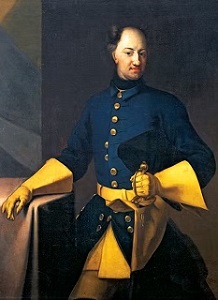
Charles XII |
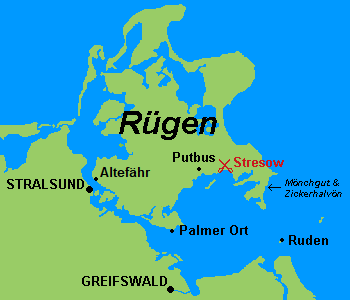
5 November 1715 (Julian Calendar)
16 November 1715 (Gregorian Calendar) |
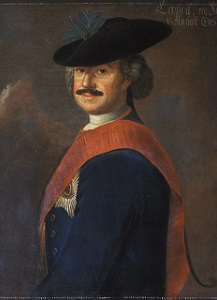
Leopold of Anhalt-Dessau |
 |
2,000 men |
 , ,
 , ,
 |
11,500 men |
The battle of Stresow was Charles XII's last
battle and it was also the first time he lost a battle in which he
personally led the Swedish army. But in no other battle were the participating armies more unequal in strength. Only 2,000 Swedes attacked a fortified camp with 11,500 Danes, Norwegians,
Prussians and Saxons inside.
The battle was a consequence of
the siege of Stralsund which the Anti-Swedish coalition had begun in 1715
with the intent of depriving Sweden of its last overseas bridgeheads. Stralsund could, however, be supplied from the island of
Rügen and the anti-Swedish coalition therefore assembled an expeditionary
force consisting of 11,000 infantry and 3,500 cavalry that would land on the
island and conquer it. The transport fleet sailed on 1 November from Eldena
Bay just east of Greifswald and threatened to land at Palmer Ort. There,
however, Charles XII was waiting for them with his main force and the fleet
instead sailed on 4 November to Stresow, which was defended by only 20
dragoons. There they managed to land all the infantry between 4 and 6 o'clock
on the afternoon. The soldiers immediatly began to build field fortifications
to protect their camp, which were finished at 9 o'clock when the artillery was
in place. After that they began to disembark part of the cavalry.
But already around 8 o'clock
Charles XII had arrived at Stresow with his cavalry. When he was told that
the enemy had already entrenched, he is claimed to have said: "Oh God we
came too late!". But if he was to prevent the enemy from capturing Rügen
and thus also Stralsund, Charles XII had no choice but to attack the camp.
However, no attack could be made until later in the night when the infantry
and artillery had arrived. Meanwhile, the Swedes reconnoitred the fortified
camp to select the site of their attack. Thanks to the onset of darkness,
this could be accomplished without being detected by the enemy. The plan
then devised was likely to attempt to repeat the feat at Narva 15 years
earlier. By focusing on a single point, the infantry was to break through
the enemy's field fortifications and then, together with the cavalry, attack
the enemy inside the camp and prevent them from exploiting their numerical
superiority. But with only two battalions against the enemy's 24, this was a
very difficult task.
Shortly after 3 o'clock at
night, the entire Swedish force was in place and could now begin the attack.
They were formed in a column with the two infantry battalions leading
followed by 20 squadrons two squadrons wide. The coalition's outposts
discovered them and the Swedes were fired upon with both musket fire and
canister shots. But without firing a shot themselves, the Swedish infantry
pushed past the chevaux de frise, went down the trench and up the breastwork,
and attacked a Danish battalion with such force that it briefly wavered.
However, the Danes recovered and together with adjacent battalions opened
fire on the Swedes and drove them back. At the chevaux de frise, the
retreating Swedes met Charles XII, who rode a horse and urged his soldiers
to carry out a second attack. But that attack too was repulsed with heavy
losses. In that moment, Charles XII is said to have exclaimed: "Is
there no longer a God on my side?" Shortly after these words both he and
the horse were shot. Men from his Drabant Corps managed to pull free the wounded
king who was lying under the dead horse. But the command of the Swedish
force was taken over by Major General Strömfelt who ordered retreat.
Before the retreat, a cavalry
battle had also been fought, which had gone better for the Swedes. A quarter
of an hour after the start of the battle, the coalition army commander
Leopold of Anhalt-Dessau ordered to send out all available cavalry to attack
the Swedes in the flank. But there were only five squadrons to send and
these were discovered by the twice as strong Swedish cavalry which was able
to repel the attack. The Swedes were therefore able, after less than an
hour's battle, to complete their retreat without being pursued by the enemy.
Remaining on the field of battle, however, were their eight cannons and
perhaps as many as 600 dead, wounded and captured men. In the following days,
Rügen fell into enemy hands without any major resistance from the Swedish
army, which retreated via Altefähr to Stralsund, which in turn fell on 12
December.´
|
|

The Battle of Stresow is a part
of the Pomeranian campaign of 1715 when a 50,000-strong combined
Danish-Prussian-Saxon army invaded Swedish-controlled Pomerania in July and
completed its conquest in December. The Swedish force defending Pomerania
had a strength of 12,000 men. When the enemy approached Stralsund to besiege
the city, the Swedish cavalry was brought over to Rügen while the infantry
manned the Stralsund fortress. However, smaller detachments from the
infantry regiments in Stralsund were also on Rügen and were part of the
force of about 4,000 men who defended the island. In addition, more than 400
dismounted cavalrymen manned a redoubt on the small island of Ruden
We have two strength reports from June and October respectively preserved in
the sources which I have summarised in the table below. However, these
strength reports are not so easy to compare with each other because the one
from October only includes the infantry regiments in Stralsund and does not
mention how many soldiers from these regiments were commandeered. In the
June report 1,604 infantrymen were commandeered, probably to other
Pomeranian fortifications in addition to Stralsund, which was then still
controlled by Sweden. Also 470 cavalrymen were commandeered and these are
probably identical to the garrison on the small fortified island of Ruden.
|
Stralsund
12 October 1715 |
|
The Swedish Army in Pomerania 9 June 1715
|
|
Infantry |
Infantry |
Cavalry |
Commandeered |
SUM
(actual) |
SUM
(in the source) |
Difference |
|
348 |
Officers |
327 |
284 |
99 |
710 |
749 |
39 |
|
538 |
NCOs |
527 |
472 |
161 |
1,160 |
1,225 |
65 |
|
258 |
Musicians |
250 |
74 |
26 |
350 |
366 |
16 |
|
5,225 |
Rank and File |
5,114 |
3,288 |
1,604 + 470 |
10,478 |
11,488 |
1,010 |
|
6,369 |
SUM |
6,218 |
4,118 |
2 360 |
12,698 |
13,828 |
1,130 |
Sick Rank and File |
676 (both infantry & cavalry and not included in the sums)
|
Note that the totals reported
in the table's source are higher than the actual totals of regimental
personnel (hence two columns in my table). The difference of just over a
thousand men probably consists of artillery and fortification personnel and
perhaps also the approx. 400 Vallacks who, according to the work by Danish
General Staff, should have been in Pomerania. However, the Vallacks are
probably identical to the Niester Dragoon Regiment that is included in the
table (but with only 96 men + at least 20 commandeered men).
The Swedish Force on Rügen
It was the force on Rügen that contributed the formations that fought the
Battle of Stresow. However, no order of battle has been preserved in the
sources, which makes it difficult to determine the number of soldiers and
which regiments took part in the battle. But the Swedish force in this
battle consisted of two battalions and 20 squadrons. The artillery consisted
of eight guns.
The Swedish General Staff's work "Karl XII på slagfältet" states the
total strength on Rügen at 3,500 men, of which ca. 750 infantry and not less
than 2,200 cavalry took part in the Battle of Stresow. However, the work
also mentions that the British envoy Jefferyes who was on the island
reported that the Rügen force was 4,000 strong. The Danish General Staff's
work "Bidrag til den store nordiske krigs historie" criticises its
Swedish counterpart for containing an incomplete and incorrect list of the
regiments on Rügen. They instead estimate the strength at between 4,000 and
5,000 men. Of these, 2,000 men took part in the battle (according to
Jefferyes) and the regimental commander of the Bender Dragoons (who were the
first to arrive at Stresow) wrote in his diary that the cavalry strength was
1,200 men. Reports from deserters put the cavalry strength at 20 squadrons
of 50 men each.
That no more than about 2,000 men out of a total force of around 4,000 men
seem to have taken part in the battle is probably due to the fact that the
Rügen force was spread across the island to guard the beaches. For example,
Charles XII could follow the movements of the enemy fleet by the various
detachments firing signal shots. In addition, a larger detachment was
stationed at Mönchgut and the Zicker Peninsula as coastal artillery.
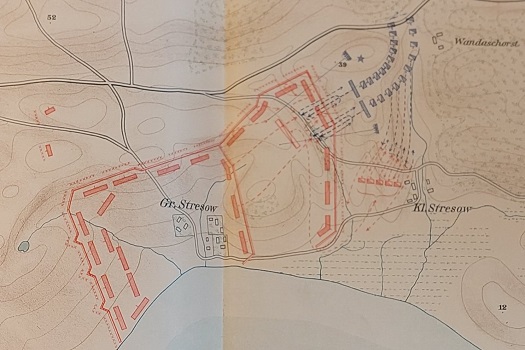
Detail of map of the Battle of Stresow from "Karl
XII på slagfältet".
The entire map and in a larger size is available as an
appendix below.
All this uncertainty makes it impossible to determine exactly which
regiments the two battalions and 20 squadrons belonged to. The Swedish
General Staff has indeed identified which regiments the infantry battalions
belonged to, but this is criticized by the Danish General Staff, which
states that one regiment was not on the island and that there were
detachments from at least five infantry regiments on Rügen. Both battalions
may therefore have been composed of personnel from several different
regiments. Since the Swedish force lacked infantry and had plenty of cavalry,
it is also not inconceivable that the infantry was reinforced with
dismounted dragoons. The cavalry also lacked proper riding horses and
therefore mainly rode ordinary peasants horses. However, the Holstein
regiments are reported to have had good horses.
Cavalry on Rügen
|
Participated in the Battle of Stresow according to the work of the
Swedish General Staff:
"Karl
XII på slagfältet"
(1,926 men)
The Drabant Corps ought to have been included here. |
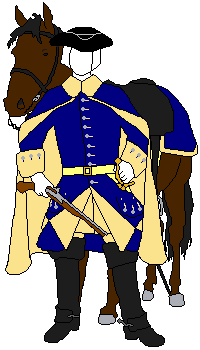 |
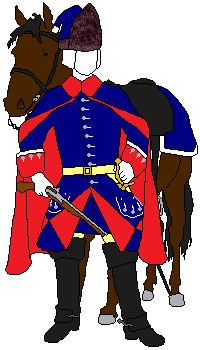 |
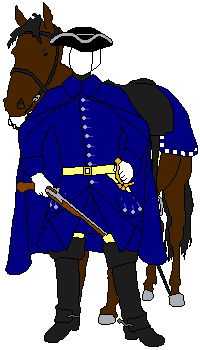 |
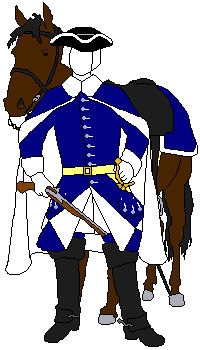 |
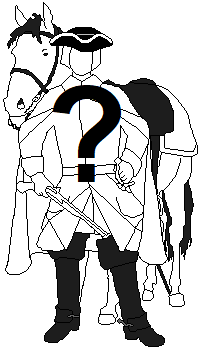 |
Holstein
Cavalry Reg.
(335 men) |
Holstein
Dragoner-Garde
(562 men) |
Bassewitz'
(Wismar) Dragoon Reg.
547 men |
Vietinghoff's
(Barth)
Dragoon Reg.
(306 men) |
Bender Dragoon Regiment
(consisted of ethnic Swedes)
(176 men) |
|
Additional troops that were wholly or partly on Rügen according to the
work of the Danish General Staff:
"Bidrag til den store nordiske krigs historie"
(1,039 men + Drabant Corps) |
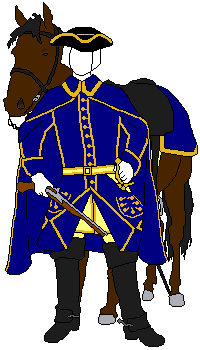 |
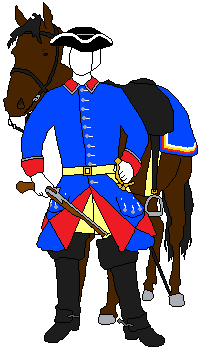 |
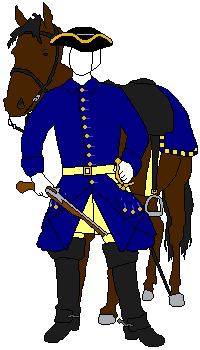 |
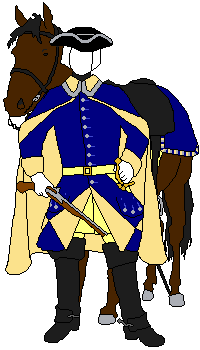 |
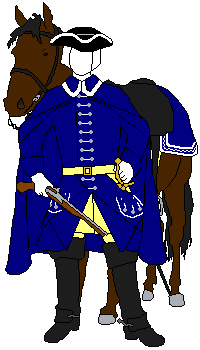 |
 |
|
Drabant Corps |
Pomeranian Cavalry Reg.
262 men |
Bremen
Cavalry Reg.
126 men |
Bremen
Dragoon Reg.
307 men |
Verden
Dragoon Reg.
249 men |
French
Dragoon Reg.
95 men |
|
Force on Mönchgut
and Zicker Peninsula
|
 |
Cavalry units that were in Pomerania, but their
whereabouts is not mentioned in the literature. |
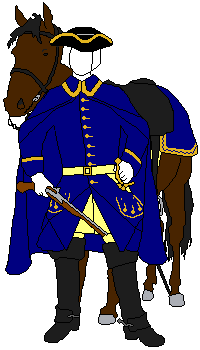 |
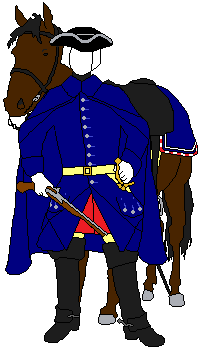 |
Niester Dragoon Regiment
(consisted of Poles)
(96 men) |
Pomeranian Dragoon Reg.
301 men |
Schwerin's Dragoon Reg.
6 men |
The strength reports of the cavalry regiments is taken from "Bidrag til
den store nordiske krigs historie" and applies to 9 June 1715. But "Karl
XII på slagfältet" states that the Bender Dragoon Regiment consisted of
176 men and not 96 men as stated by the Danish General Staff. This despite
the fact that they obviously use the same source. The Danes, however, state
96 men for both the Bender and Niester regiments. Could they have written
the Niester regiment's number twice? In the table of the strength of the
regiments on 9 June, the Danish General Staff also commented that the
Vallacks, which should have consisted of about 400 men, were missing from
the table. But the Vallacks are probably identical to the Niester Dragoon
Regiment.
The Bender dragoons were part of the 300 men strong vanguard that, together
with Charles XII, arrived at Stresow around 8 o'clock pm (one source says it
happened between 7 and 8 o'clock while another says it happened at 9
o'clock). The Drabant Corps was probably also part of this vanguard.
According to "Karl XII på slagfältet"", the wounded Karl XII was
rescued by a Corporal Baumgarten of the Drabant Corps. So although this work
does not explicitly list the Drabant Corps as participants in the battle, it
was at least partially present there. The Danish General Staff Office also
mentions another drabant who helped save the king (Tungelfelt).
Infantry on Rügen
|
Artillery on Rügen
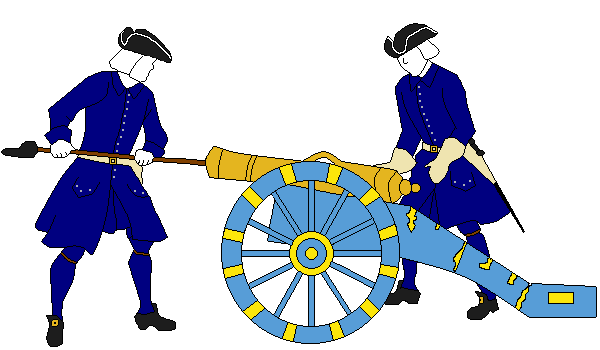 |
|
8 cannons at Stresow |
4 cannons at Mönchgut and Zicker
peninsula |
According to "Karl XII på slagfältet",
the infantry at the Battle of Stresow consisted of 750 men distributed
among one battalion each from the Pomeranian and Bremen infantry
regiments. In addition, the Rügen National Militia and crews from three
warships were stationed on Mönchgut and Zicker Peninsula southeast of
Stresow. These regiments also had detachments located in Stralsund.
"Bidrag til den store
nordiske krigs historie" criticises its Swedish counterpart and
claims that the Pomeranian infantry regiment was
not present at all on Rügen. However, in addition to Bremen and
Rügen, it also lists the Jönköping, Rheinland and Holstein regiments as
fully or partially present on Rügen. In addition, officers from the
Wismar, Stralsund and Holstein regiments were captured on Rügen.
There is no doubt that Jönköping's regiment was not only on the island
but also took part in the battle. It is confirmed in the sources that
they suffered losses in the battle (read more about in the section on
casualties).
Mönchgut and Zicker Peninsula
The force stationed at Mönchgut
and Zicker Peninsula in south eastern Rügen under Lieutenant Colonel
Stenflycht's command served as coastal artillery. It also protected three
Swedish frigates that had taken refuge in Zicker Bay. The crews of these
ships subsequently formed part of the force but their guns cannot reasonably
be included in the figure of four artillery pieces mentioned in the General
Staff works. In addition to the sailors and the artillery, this force
consisted of the Niester Dragoon Regiment and the Rügen National Militia.
The work of the Danish General Staff states that they consisted of about 200
dragoons and about 300 infantrymen. But this collides with the same work's
claim that the Niester dragoons in June 1715 only had 95 men. Admittedly,
officers as well as sick and commandeered men were not included in the
latter figure, but it is still a big difference because the commandeered men
were probably in Ruden (see below).
After the Battle of Stresow, the trapped frigates were burned and the troops
were evacuated to Stralsund. The dragoons took the short route and passed
the coalition army by only six kilometres. The infantry under Stenflycht's
command, on the other hand, took the long way up to northern Rügen where
they got hold of boats that could take them to Stralsund. Along the way they
also met other Swedish soldiers who joined and increased its strength to 600
men.
The
Ruden Command
(419 men in total)
Stralsund Garrison
The distribution of the
regiments below and the strength reports in red
indicate the situation on 12 October 1715. For comparison, I have
also included the strength report from 9 June 1715 in
black text. 16 The figures are not completely comparable because in
the month of June 1,604 men were also reported as "commandeered" and 676 men
as sick without indicating any regimental affiliation for these. Even in the
month of October, some regiments should have left personnel for commands on
Rügen. During the course of the siege, some reinforcements also arrived from
the homeland, which explains why the Jönköping regiment increased its
strength between June and October (and then the regiment may also have had a
detachment on Rügen which is not included). In addition, a prisoner exchange
took place at the turn of June/July which resulted in 161 Holstein soldiers
being freed from Prussian captivity. These soldiers most likely reinforced
Delwig's regiment and the Holstein Leibregiment.
The garrison was divided into
four commands, one of which constituted a reserve. Knieper Thor formed the
northern front confronted by the Danes, Triebser Thor the western front
confronted by the Prussians, and Franken Thor the southern front confronted
by the Saxons. Altogether, the four departments consisted of
5,252 men. Stralsund was a
strong but undermanned fortress because the fortifications were designed for
26,000 men.
Knieper Thor (941 men)
|
Triebser Thor
(2,104 men) |
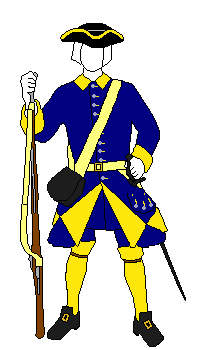 |
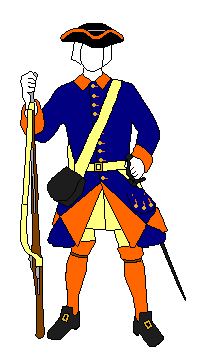 |
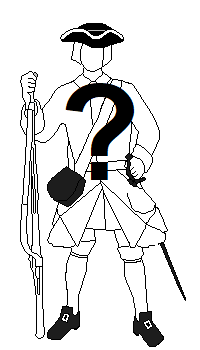 |
 |
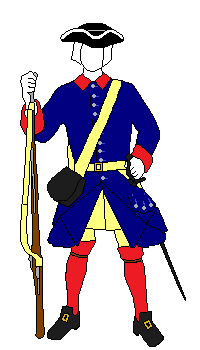 |
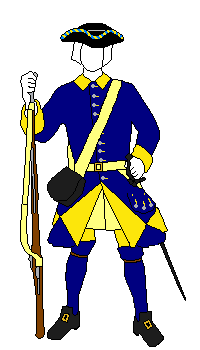 |
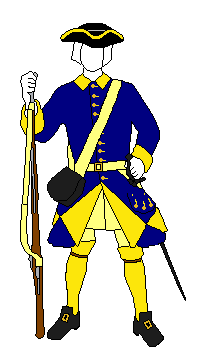 |
 |
Wismar Regiment
451 men
300 men |
Bremen Regiment
268 men
325 men |
Stettin
National Militia
402 men
316 men |
Wrangel's Regiment
440 men
446 men |
Jönköping Regiment
388 men
822 men |
Tyska livregementet
342 men
282 men |
Malmö Garrison
Regiment
259 men
278 men |
Rheinland Regiment
388 men
276 men |
Franken Thor and the Retrenchments
(1,422 men)
|
Reserve
(785 men) |
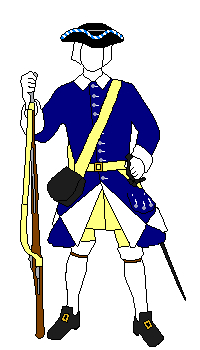 |
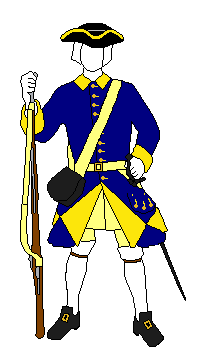 |
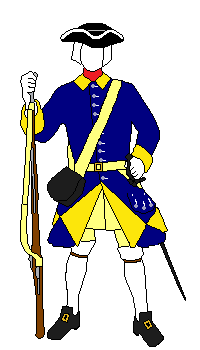 |
 |
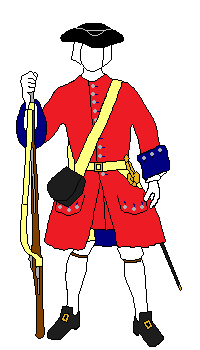 |
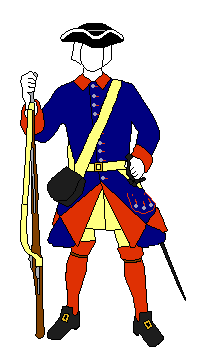 |
 |
 |
Riksänkedrott-ningens livreg.
312 men
396 men |
Pomeranian Regiment
469 men
423 men |
Elbing Regiment
126 men
49 men |
Anklam
National Militia
68 men
39 men |
Delwig's Holstein Regiment
413 men
515 men |
Stralsund Regiment
229 men
235 men |
Rügen
National Militia
485 men
401 men |
Holstein Leibregiment
74 men
149 men |
|
|

The coalition army assembled at
Greifswald in October and then shipped over to Rügen consisted of 24
battalions and 35 squadrons. If the participating regiments were at full
strength, this army would have consisted of at least 20,000 men (13,814
infantry and 6,186 cavalry). But the real strength was significantly lower.
According to the Danish General Staff, the 438-ship transport fleet had only
been ordered to have room for 17,219 men and 5,183 horses. These numbers
also include more than just rank-and-file soldiers, but also officers,
baggage train and other non-combatants. This means that the rank and file
should not have been more than 3,500 cavalry and 11,000 foot soldiers
The Danish General Staff has
not given any figures of the national distribution of the army. However, the
German historian Hermann Voges has done that when he reported the planned
order of battle. For Danes and Prussians, however, it is obvious that he has
stated the nominal strength of the regiments and thus lands on a total
strength that would not have been able to fit on the transport fleet. I have
therefore made my own calculation of these figures to make them match the
Danish General Staff's estimate.
|
Coalition Army Strength According to Hermann Voges
|
My
Estimate of the Strength
|
|
Infantry |
|
Battalion Strength |
Rank & File |
Battalion Strength |
Saxons
Prussians
Danes & Norwegians |
1,485
5,479
6,850 |
Kavanagh 405, the rest 360
Grenadiers ca 464, the rest 632
685 men |
1,400
4,600
5,500 |
350
460
550 |
|
Sum |
13,814 |
|
11,000 |
|
| |
|
|
|
|
|
Cavalry |
|
Squadron Strength |
Rank & File |
Squadron Strength |
Saxons
Prussians
Danes |
324
2,838
3,024 |
162 men
Gens d'Armes 300, the rest ca 181
168 men |
200
1,500
1,800 |
100
100
100 |
|
Sum |
6,186 |
|
3,500 |
|
Total Sum |
20,000 |
14,500 |
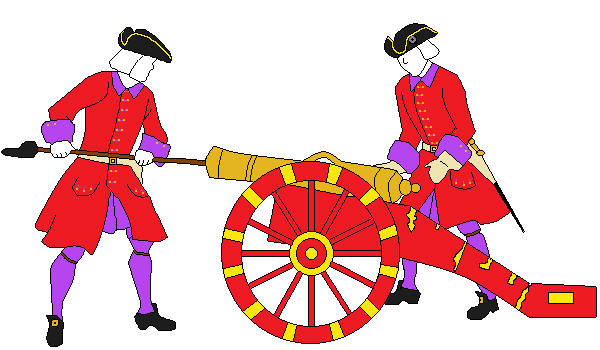 Not
included in the table is the artillery which consisted of 26 cannons.
Neither the manpower nor its national distribution is reported. But it
was under Danish command (Colonel Archot) and the number of cannons
corresponds to the 120 men strong regimental artillery that the Danish
army brought to Pomerania. Not
included in the table is the artillery which consisted of 26 cannons.
Neither the manpower nor its national distribution is reported. But it
was under Danish command (Colonel Archot) and the number of cannons
corresponds to the 120 men strong regimental artillery that the Danish
army brought to Pomerania.
Planned Order of
Battle
Field Marshal Leopold of Anhalt-Dessau.
Right Wing
Second Line
— Lieutenant General von Wittau
Actual Order of
Battle
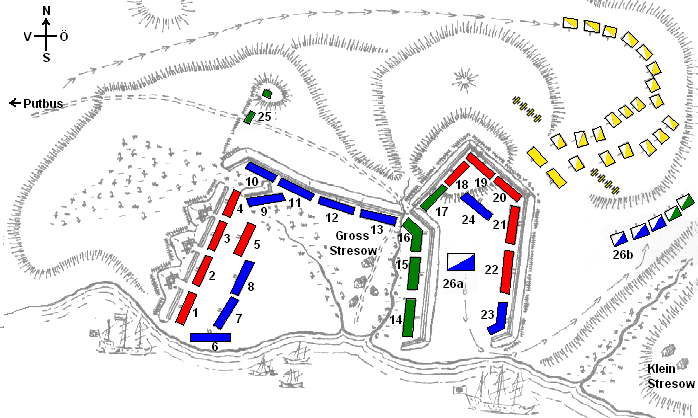
An edited version of a map from "Chakoten
Jubilæumudgave 1969 ".
The coalition army began the
landing at Stresow at 4 o'clock pm on 4 November. After two hours all the
infantry were ashore (24 battalions) and they immediately set about building
a fortified camp surrounded by breastworks, trenches and chevaux de frise.
At 9 o'clock the field fortifications were finished and all the artillery
had arrived. The landing of the cavalry, however, did not begin until 10
o'clock. Admiral Sehested claimed that he had managed to bring over 2,000
cavalry to Stresow before 1 o'clock am, but still only five squadrons could
be deployed when the battle began just after 3 o'clock in the morning.
The exact layout of the
fortified camp at Stresow is unclear. There are several maps that differ
from each other. I have included two maps in this section that I have
coloured for clarity. Also, I have the same numbering of the individual
battalions on both maps for ease of comparison. In addition to this, there
are also the originals and additional maps at the bottom of the page as
appendices.
The force numbered 25 on the map above consisted of 200 Saxons who had been
detached from Kavanagh's regiment. The lower map from the work of the Danish
General Staff, on the other hand, indicates that half the force was made up
of Prussians.
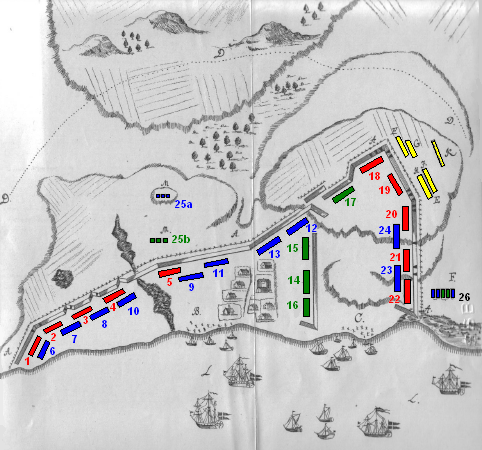
An edited version of a map that is included as an
appendix in the work of the Danish General Staff,
The map from the Danish General Staff is misleading in that it gives
the impression that it was the battalion from the Norwegian enlisted
regiment (No. 19) that was at the centre of the Swedish attack. In fact, it
was the Jyske (Jutland) Regiment's battalion (No. 20) that almost
single-handedly resisted the Swedish infantry's two attacks. When the
Jutlanders were subjected to the second attack, a Prussian general suggested
sending forward the reserve, to which Leopold of Anhalt-Dessau replied:
"Nein! sie haben schon den Feind geschmissen und repoussiret, und dieweil
sie allein haben des Werck gethan, so müssen sie auch allein die Ehre Haben"
("No! they have already thrown back and repulsed the enemy, and as they
alone have done the work, they alone must have the glory") |
|

The Anti-Swedish Coalition
It was the Jyske battalion that
defended the place that the Swedish infantry attacked. Consequently, they
suffered the highest losses on the coalition side. Both its colonel and
major and three other officers were killed. 75 privates had either died or
been wounded during the battle. The losses for the Norwegian enlisted
battalion were 12 men and for Prince Carl's battalion only two men. Since it
was only these three battalions that had taken part in the battle, the total
infantry losses were therefore 89 men killed or wounded.
The cavalry that had been sent
out a quarter of an hour after the start of the battle to attack the Swedes
in the flank had fought at a disadvantage and therefore suffered relatively
high losses. The Saxons' two squadrons had lost two officers and 34 dragoons.
The three squadrons of the Prussians had lost a colonel and 49 men (24
gendarmes and 25 horse grenadiers). All in all 83 casualties for a force of
perhaps only 500 men.
The Swedes
The information regarding
Swedish losses in the battle differs in the various (non-Swedish)
sources. Admiral Sehested who was in command of the landing fleet stated
that over 100 men were killed and that 300 were captured or deserted. The
Saxon general Wilcken, who was in command of the infantry during the Rügen
campaign, stated that between 400 and 500 Swedes were killed and that 100
were captured. The British envoy Jefferyes who was on the Rügen claimed the
total losses to be three generals and 600 men. While the casualty figures
are uncertain, it does appear that Charles XII lost at least a quarter of
his force at Stresow. In the distribution of losses, it should reasonably
have been the infantry that suffered the hardest.
For Jönköping regiment, we
have the names of three non-commissioned officers who died in the battle.
Furthermore, S. G. von Kothen's curriculum vitae mentions that few men from
Jönköping regiment, but all colours, returned after the action on Rügen. For comparison,
it can also be mentioned that in October the regiment had 822 men on duty at
Stralsund fortress (this figure does not include sick and commandeered
personnel). By December its strength was reduced to 338 men on duty and 267
sick and wounded (a total of 605 men left of a regiment with a nominal
strength of 1,100 men).
Charles XII himself was shot in
the chest during the battle and got stuck under a dead horse. It was with
difficulty that his Drabants succeeded in pulling him free and saving him
from captivity. Major Generals Bassewitz and Grothusen and Colonel Wöllwart
were killed in action. Major General Dahldorff and Lieutenant Colonel Jakob
Torstensson were mortally wounded.
At Altefähr on 7 November, the
part of the Rügen force that had not managed to be shipped over to Stralsund in time,
surrendered to the Coalition army (650 men according to Jefferyes). They seem to have
consisted almost exclusively of dragoons and the Danes have reported the
following composition of the haul: one lieutenant general, three major
generals, four colonels, two lieutenant colonels, four majors, 31 captains,
58 lieutenants & cornets and 540 non-commissioned officers and men. The high
proportion of officers in relation to the rank and file was due to the fact
that the manpower of the regiments was greatly reduced, while vacancies
among the officers were constantly filled by promotions. In addition to
these, there were likely to have been smaller groups of Swedish soldiers
scattered on Rügen who were captured on other occasions.
At Altefähr, 2,000 men managed
to be evacuated to Stralsund. And via boats from northern Rügen, another 600
men led by Stenflycht managed to get to Stralsund. This was all that
remained of the original force of around four thousand men, and a month
later they too would be captured when Stralsund capitulated on 12 December.
|
|
Appendices
Battle of Stresow
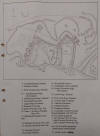 |
 |
 |
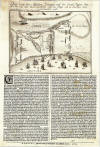 |
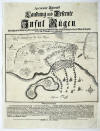 |
 |
|
Printed from
Daniel Schorr's website Northern Wars before he shut it down in 2010,
and in
2014 erased all traces of it on the Internet. The map was originally
published in Chakoten Jubilæumsudgave 1969. |
From volume 7
of the Danish General Staff's work "Bidrag til den store nordiske krigs
historia" (1922). The original in Hærens arkiv in
Copenhagen. |
From the the
Swedish General Staff's work "Karl XII på slagfältet" (1919)
and produced by their lithographic institute. |
From Wikpedia. |
From Wikpedia. |
From Otto Vaupells
work "Den danske Hærs Historie til Nutiden og den norske Hærs Historie til
1814 I-II" (1872-1876). The map does not match the sources and
is of "unknown provenance". |
Sieges of Stralsund (the one in 1715 unless otherwise stated)
|
 |
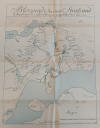 |
 |
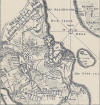 |
 |
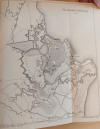 |
|
Siege of
Stralsund 1711-1712. From Wikipedia. |
Siege of
Stralsund 1711-1712. From volume 3 of the Danish General Staff's work "Bidrag
til den store nordiske krigs historia" (1906). The original in
the Swedish krigsarkivet. |
From volume 7
of the Danish General Staff's work "Bidrag til den store nordiske krigs
historia" (1922). The original in the Swedish krigsarkivet. |
From Wikpedia. |
From
Wikipedia. |
From Otto Vaupells
work
"Den danske Hærs Historie til Nutiden og den norske Hærs Historie til
1814 I-II" (1872-1876). |
|
|
References
Generalstaben (red. Carl Bennedich). Karl XII på slagfältet.
Stockholm (1919)
Tidander, L. G. T. Anteckningar rörande Kongl. Jönköpings regementes
historia. Västerås (1910)
Tuxen, A. P. - With-Seidelin C. L. Bidrag til den store nordiske krigs
historie volume 6 and 7. Copenhagen (1920, 1922)
Voges, Hermann. Beiträge zur Geschichte des Feldzuges
von 1715. (article in Baltische Studien,
volume IX)
Stettin (1905) |
|

